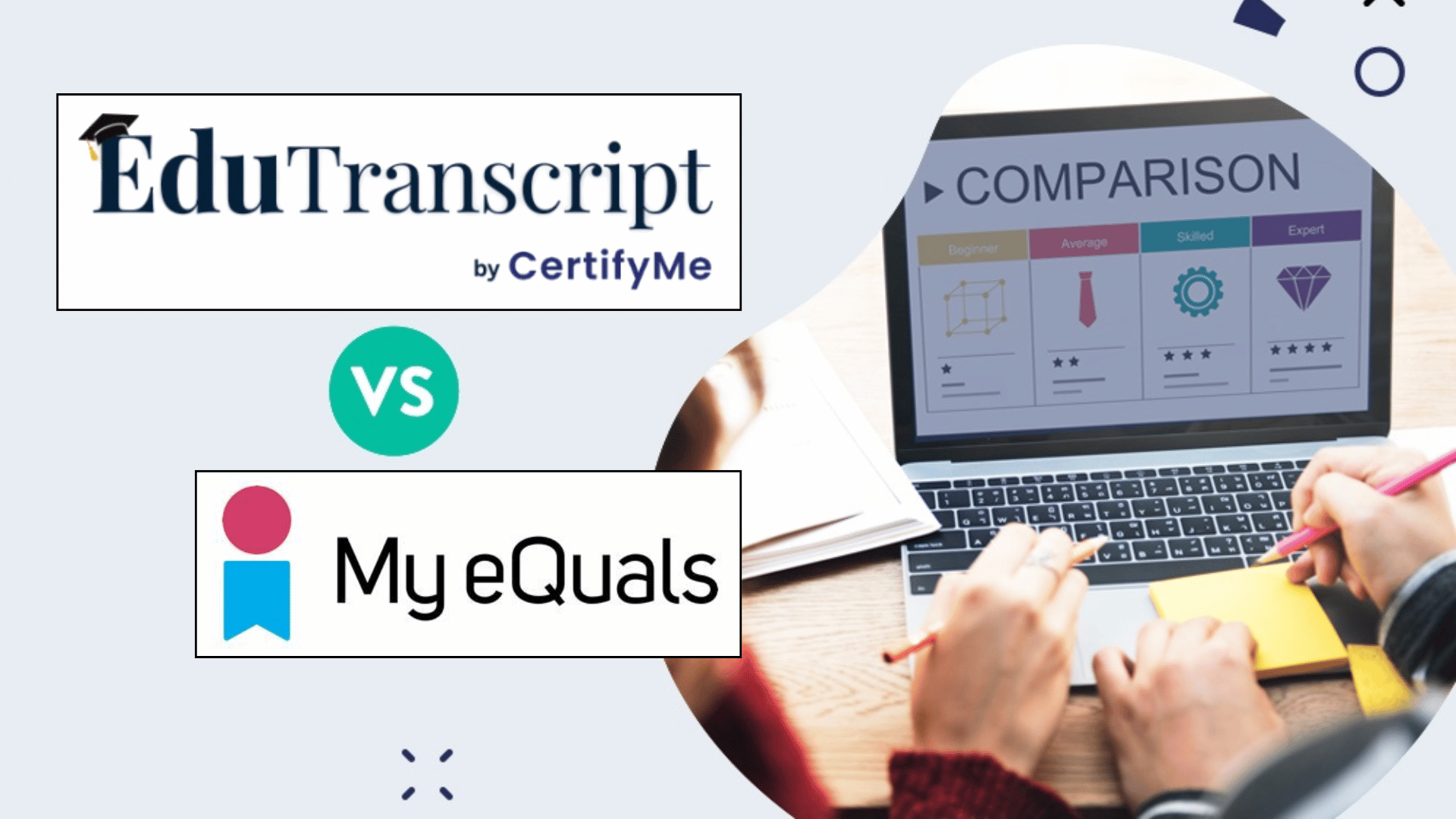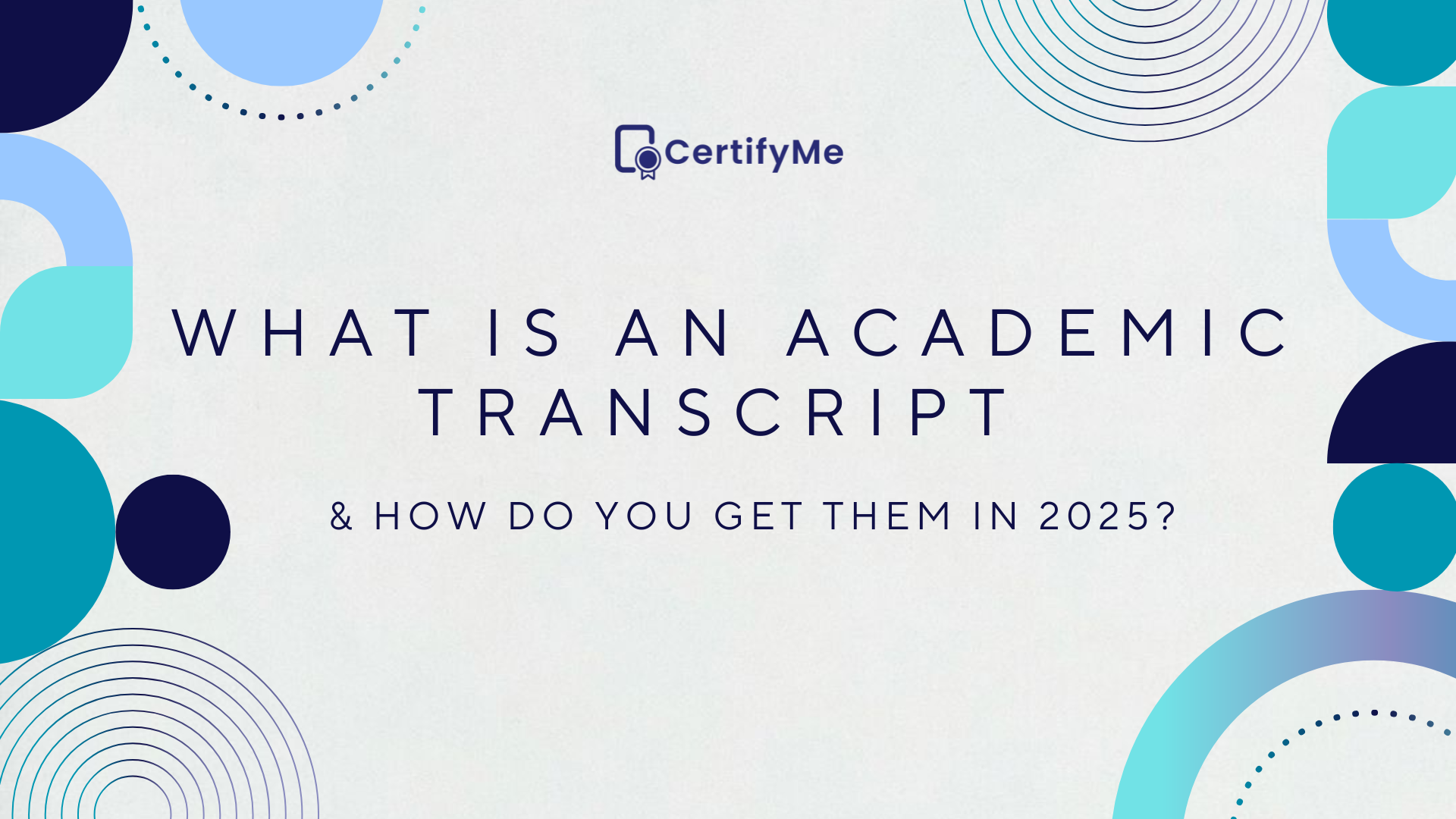Although EduTranscript and My eQuals both allow universities to issue and manage secure, verifiable transcripts, the way they operate and the flexibility they offer are quite different – and each may be the right choice in different situations.
My eQuals has long been the recognised standard across Australia and New Zealand, with strong sector-wide adoption and familiarity among local employers and agencies. EduTranscript, backed by CertifyMe, takes a more boutique approach, offering greater customisation, faster feature delivery, and advanced options for automation, analytics, and branding.
We’ve looked closely at how each platform performs in the areas that matter most to universities – especially registrar teams and IT departments – so you can see where they differ and decide which will serve your institution best.
So let’s get into it…
Understanding Digital Transcript Management in Higher Education
Before diving into the platform comparison, let’s establish what modern transcript management should accomplish for your institution.
Digital transcript management platforms handle the entire lifecycle of academic credentials – from initial creation and approval workflows to final verification by employers and agencies. These systems need to integrate seamlessly with your Student Information System (SIS), maintain strict security standards, and provide a smooth experience for both your staff and students.
The key difference between platforms often lies in their approach to automation, integration capabilities, and the level of control they offer institutions. Some platforms prioritize sector-wide standardization, while others focus on institutional flexibility and customization.
For ANZ universities specifically, any transcript management solution must navigate the unique regulatory environment, integrate with common SIS platforms like PeopleSoft and Ellucian, and maintain recognition among local employers and international verification agencies.
Quick Comparison Summary : EduTranscript vs My eQuals
| Feature | EduTranscript | My eQuals | Verdict |
|---|---|---|---|
| Security & Compliance | Creates digitally signed documents with extra controls like BYOK (you control encryption keys), custom data retention rules, and detailed audit logs. More options to customize security for your institution. | Creates digitally signed documents with proven security across ANZ universities. Uses standard security practices that work well for most institutions. | Tie - Both have strong security. EduTranscript wins if you need more control over security settings. |
| SIS Integration | Uses REST APIs for instant updates (no waiting for overnight syncing), includes testing sandbox, SAML SSO (login with university credentials), and auto-creates user accounts. Faster to connect new systems. | Has working connections with ANZ systems like PeopleSoft and Ellucian. These connections have been used for years and work reliably. | EduTranscript - Better for instant updates and connecting new systems quickly. |
| Workflow Automation | Handles complex approval steps (school → faculty → registry), processes large batches at once, shows where documents are in the queue, and retries failed processes automatically. | Uses standard templates for common document types and handles basic approval chains well. Less flexible for unique workflows. | duTranscript - Much better automation and bulk processing saves significant manual work. |
| Verification & Recognition | Puts verification on your university website with your branding, uses simple QR codes and links, works well for international verifiers. | Most recognized by ANZ employers and agencies who know and trust the system. Consistent process that local verifiers understand. | My eQuals - Better for local recognition; EduTranscript better for branding/international use. |
| Scalability & Performance | Automatically scales up during busy periods, provides written guarantees (SLAs) for uptime and processing speed, shows live queue status, and warns about issues early. | Has handled ANZ graduation seasons well for years with stable performance. Reliability comes from proven track record, not written guarantees. | EduTranscript - Wins with written performance guarantees and better monitoring tools. |
| Pricing Flexibility | Offers different payment options (subscription or students pay), shares revenue with universities, lets you waive fees for disadvantaged students, and matches your budget needs. | Uses set consortium fees that are predictable. Fewer options to share costs or automatically help students with fees. | EduTranscript - Much more flexible with pricing and helping students who can't afford fees. |
| Analytics & Reporting | Shows real-time dashboards of processing queues, failure rates, processing times, and verification patterns. Exports data to analysis tools for better decision-making. | Provides basic reports on document creation and usage. Less detailed and no real-time information. | EduTranscript - Much better live data helps you spot problems and improve operations. |
| Student Experience | One branded portal for all student credentials, 24/7 vendor support (reduces your workload), works on mobile, and meets accessibility standards. | Familiar steps that ANZ students know, with help guides. Your university staff handle student support questions. | EduTranscript - MuTakes support burden off your team and gives students a better experience. |
| Vendor Partnership | Gives you a dedicated account manager, responds quickly to requests, lets you help design new features, and rolls out changes faster. | Uses group decision-making across all universities, shared development priorities, and predictable but slower changes. | EduTranscript - Better for quick responses and personal attention; My eQuals better for sector-wide consistency. |
Security, Authenticity & Compliance
EduTranscript Verification and Compliance
EduTranscript takes a comprehensive approach to security and compliance, offering digitally signed documents with both online and QR code verification options. The platform includes revocation and expiry controls, giving institutions the ability to manage credentials throughout their entire lifecycle.
What sets EduTranscript apart is its institution-level configuration options. According to our internal analysis, the platform offers configurable retention policies, legal hold capabilities, and potential Bring Your Own Key (BYOK) or Key Management Service (KMS) integration.
BYOK essentially means your institution maintains control over the encryption keys used to protect your data, rather than relying solely on the vendor’s key management – an important consideration for institutions with strict data sovereignty requirements.
The platform maintains AU/NZ privacy compliance, implements multi-factor authentication (MFA), provides role-based access controls, and maintains complete audit trails for all system activities.
My eQuals Verification and Compliance
My eQuals has built its reputation on providing digitally signed documents with a trusted and widely recognized verification process. The platform has established a proven compliance record across ANZ universities and follows sector-approved security practices.
The system offers standard retention and auditing capabilities that have served the sector well over many years. Its security approach focuses on consistency and reliability rather than institution-specific customization.
Which Platform is Best Here? (Verdict)
Both platforms deliver strong fundamental security and authenticity features. EduTranscript takes the edge if your institution needs advanced, institution-specific controls like BYOK or custom retention policies.
These features become particularly valuable for universities with complex compliance requirements or those operating under specific legal frameworks.
If you’re currently using My eQuals: If your compliance team is pushing for more control over data retention or encryption, EduTranscript’s additional configuration options present a compelling case for transition. However, if your current compliance and audit processes are well-served by existing capabilities, there’s no pressing security-related need to change platforms.
SIS Integrations & Identity Management
EduTranscript Integrations and Identity Tools
EduTranscript offers REST APIs with webhook support for real-time updates – a technical term that simply means the platform can automatically sync with your SIS immediately when changes occur, rather than waiting for overnight batch updates. This real-time capability can significantly reduce delays in transcript processing and student access.
The platform provides a sandbox environment for testing integrations before going live, along with comprehensive API documentation. For identity management, EduTranscript supports SAML SSO (Single Sign-On, allowing users to access the system using their existing university credentials) and SCIM for automated user provisioning.
SCIM essentially automates the process of creating and managing user accounts based on your existing directory services. The platform also offers detailed role-based controls, allowing you to define exactly what different staff members can access and modify within the system.
My eQuals Integrations and Identity Tools
My eQuals has established proven integrations with ANZ SIS platforms including PeopleSoft, Ellucian, and TechnologyOne/Callista. These integrations have been refined over years of use across multiple institutions, resulting in reliable and well-understood processes.
The platform supports SSO and provides familiar administrative roles that align with typical university organizational structures. The emphasis here is on stability and familiarity rather than cutting-edge integration features.
Which Platform is Best Here? (Verdict)
EduTranscript wins in this category due to its real-time integration capabilities and more streamlined onboarding process for new systems. According to our platform analysis, institutions can typically implement and test new integrations more quickly with EduTranscript’s modern API architecture.
If you’re currently using My eQuals: If your team regularly deals with delays from nightly batch updates or manual data synchronization processes, EduTranscript’s real-time integrations can eliminate these pain points. This is particularly valuable for institutions adding new SIS modules or planning system upgrades. However, if your existing My eQuals integrations are stable and require minimal maintenance, staying with the current setup makes practical sense.
Issuance & Workflow Automation
EduTranscript Issuance and Workflow
EduTranscript excels in handling complex approval workflows that match typical university hierarchies – from school level to faculty to central registry. The platform supports multi-step approval processes while maintaining visibility into where each document sits in the approval chain.
The system offers bulk operations for issuing, reissuing, or revoking credentials by cohort, which can be a significant time-saver during graduation periods. Queue visibility features allow staff to monitor processing status in real-time, while automated retry functions handle temporary failures without manual intervention.
Automatic notification systems keep relevant parties informed throughout the process, and live monitoring provides insights into throughput and exception handling.
My eQuals Issuance and Workflow
My eQuals provides standard templates for common document types and works efficiently for straightforward approval chains. The platform has been optimized for the most common university workflows and delivers reliable performance for standard processes.
However, the system offers limited flexibility for institutions with unique or complex approval requirements that don’t fit standard templates.
Which Platform is Best Here? (Verdict)
EduTranscript wins this comparison with its more sophisticated approval pathways and bulk management capabilities, which can significantly reduce manual work for large or complex institutions.
If you’re currently using My eQuals: If your institution regularly faces delays from multi-step approval processes or needs to process large batches of transcripts quickly (particularly during graduation seasons), EduTranscript’s automation features can dramatically improve efficiency.
The platform is also better suited to institutions with diverse faculty-specific processes that require customized workflows. However, if your current approval processes are straightforward and run without significant bottlenecks, the additional complexity may not need a platform change.
Verification Experience & Domestic Acceptance
EduTranscript Verifier UX and Branding
EduTranscript offers verification hosting on your institution’s domain with full university branding. This means when employers or agencies verify a transcript, they see your university’s brand and domain rather than a third-party verification service.
The platform provides simple link and QR code verification with the ability to include custom guidance text. This approach is particularly strong for international verification scenarios where brand recognition and clear institutional identity matter.
My eQuals Verifier UX and Branding
My eQuals enjoys the highest recognition within ANZ, with established trust among domestic employers and recruitment agencies. The platform offers a consistent verification flow that minimizes confusion for local verifiers who are already familiar with the system.
This recognition advantage is significant – many local employers and agencies have My eQuals verification built into their standard processes.
Which Platform is Best Here? (Verdict)
My eQuals wins for domestic verification due to its strong market recognition, while EduTranscript offers advantages for brand control and global reach.
If you’re currently using My eQuals: If a significant portion of your graduate verifications come from outside ANZ, or if institutional branding is important to your university’s identity strategy, EduTranscript offers clear benefits.
The platform is also valuable if you frequently receive “is this credential genuine?” queries from overseas employers or agencies. However, if your graduates primarily work within ANZ and verification queries are rare, the established recognition of My eQuals may outweigh branding considerations.
Scalability & SLAs (Peak-Load Performance)
EduTranscript Scalability at Graduation Season
EduTranscript offers elastic capacity during peak periods – meaning the system can automatically scale up processing power during high-demand times like graduation season. The platform provides live queue monitoring and bulk retry capabilities to handle processing exceptions efficiently.
Importantly, EduTranscript provides contracted Service Level Agreements (SLAs) for both uptime and processing times. SLAs are formal commitments about system performance that include penalties if the vendor fails to meet agreed standards – providing you with recourse if the system doesn’t perform as promised.
The platform also includes proactive incident communication, keeping institutions informed about any performance issues before they impact operations.
My eQuals Scalability at Graduation Season
My eQuals has demonstrated proven performance during peak graduation periods across ANZ institutions over many years. The platform has stable, well-understood processes that staff are familiar with, though it offers fewer institution-specific tuning controls.
The system’s reliability comes from its track record rather than contractual performance guarantees.
Which Platform is Best Here? (Verdict)
EduTranscript wins narrowly in this category due to its contractual SLAs and more granular operational controls, while My eQuals offers the advantage of a longer local track record.
If you’re currently using My eQuals: If your institution has experienced delays or processing backlogs during peak graduation periods, EduTranscript’s SLA-backed capacity can provide additional assurance and accountability.
Institutions that want more visibility into processing queues and the ability to monitor system performance in real-time will find value in switching.However, if your peak period processing already runs smoothly, the existing proven performance may be sufficient.
Total Cost of Ownership & Pricing Optics
EduTranscript Pricing Options
EduTranscript offers flexible pricing models including both subscription and student-pay options with revenue sharing arrangements. The platform includes options to waive or subsidize fees for equity groups, which can be important for institutions focused on accessibility and social responsibility.
This flexible cost alignment allows institutions to better match pricing structures with their budgets and institutional policies, particularly around student fees and equity considerations.
My eQuals Pricing Options
My eQuals operates as a consortium service with established fee structures. Student fee policies differ by institution, but there are fewer built-in options for revenue sharing or automatic subsidies.
The cost structure is predictable and well-understood across the sector, which simplifies budgeting and financial planning.
Which Platform is Best Here? (Verdict)
EduTranscript wins with greater flexibility in pricing and funding models, particularly for institutions with specific budget constraints or equity objectives.
If you’re currently using My eQuals: If fee structures are a concern for your institution or if budgets are under strain, EduTranscript’s revenue share and subsidy options can ease financial pressure.
The platform is also useful if you need cost alignment with access and equity goals. However, if your current funding model is financially sustainable and acceptable to stakeholders, the predictable My eQuals structure may be preferable.
Analytics & Operational Insight
EduTranscript Analytics and Reporting
EduTranscript provides real-time dashboards showing processing queues, failure rates, and processing times. The platform includes comprehensive analytics on document sharing and verification patterns, with export capabilities for Business Intelligence tools.
This data enables institutions to optimize staffing patterns, identify bottlenecks, and improve operational workflows based on actual usage patterns rather than assumptions.
My eQuals Analytics and Reporting
My eQuals offers standard issuance and usage reports that cover basic operational needs. The platform provides less real-time visibility into operations but works well for steady-state monitoring and reporting.
The reporting focuses on essential metrics rather than detailed operational analytics.
Which Platform is Best Here? (Verdict)
EduTranscript wins by providing live, actionable data that can drive operational improvements and better resource allocation.
If you’re currently using My eQuals: If you currently lack immediate visibility into processing backlogs or verification patterns, EduTranscript’s dashboard capabilities can close that information gap.
The platform is also helpful for providing detailed performance reports to institutional leadership. However, if your current reporting meets your operational needs and decision-making requirements, additional analytics may not justify a platform change.
Student Experience & Support Load
EduTranscript Student Portal and Support
EduTranscript provides a unified, branded digital wallet where students can access transcripts, certificates, letters of recommendation, and digital badges in one location. The platform includes 24/7 vendor-managed student support, reducing the burden on university help desks.
The student interface is mobile-friendly and accessibility compliant, ensuring all students can easily access their credentials regardless of their technical capabilities or assistive technology needs.
My eQuals Student Portal and Support
My eQuals offers familiar processes that ANZ students recognize, with extensive documentation in university help guides. However, student support is typically handled by university service desks rather than the vendor.
This support model can lead to high ticket volumes during peak periods, particularly when students are accessing credentials for job applications or further study.
Which Platform is Best Here? (Verdict)
EduTranscript wins by reducing registrar workload through vendor-managed support and providing a more comprehensive student credential interface.
If you’re currently using My eQuals: If peak graduation and application seasons cause support backlogs or if students frequently need assistance accessing their documents, EduTranscript can significantly relieve pressure on your service desk.
The unified credential wallet also improves the overall student experience by consolidating all academic credentials in one accessible location. However, if your support load is currently low and manageable, the existing familiar processes may be sufficient.
Governance & Vendor Partnership
EduTranscript Support and Partnership
According to our analysis, EduTranscript provides named account managers for personalized service and typically offers quicker response times to institution-specific needs. The platform enables co-design of new features and typically delivers faster rollouts of requested functionality.
The vendor relationship includes clear escalation paths and more direct communication channels for addressing unique institutional requirements.
My eQuals Support and Partnership
My eQuals operates under a consortium governance model with sector-priority roadmap planning. This approach provides predictable change cycles and shared best practices across participating institutions.
The consortium model ensures that platform development serves sector-wide needs rather than individual institutional preferences.
Which Platform is Best Here? (Verdict)
EduTranscript wins for institutions prioritizing speed and personalized attention, while My eQuals offers advantages for those valuing sector-wide alignment and predictable development cycles.
If you’re currently using My eQuals: If your institution has struggled to get unique requirements prioritized or has felt limited by slow change cycles, EduTranscript’s more responsive partnership model offers faster, tailored attention.
This is particularly valuable for institutions wanting direct input into roadmap planning. However, if you value the predictability and sector alignment of the consortium model, My eQuals’ approach may better match your institutional culture.
EduTranscript vs My eQuals: Which is Best for Your Institution?
Both My eQuals and EduTranscript allow universities to manage digital transcripts, but I’m sure you’ll agree that EduTranscript is a much more comprehensive and advanced transcript management solution, especially if you’re looking to streamline operations for your registrar team.
EduTranscript allows you to create automated workflows, real-time integrations, and detailed analytics dashboards in the process. Plus, it’s incredibly flexible to set up and customize for your institution’s specific needs. It’s a powerhouse for reducing manual work and providing better service quality to your students and staff.
However, all that comes with the consideration of platform transition costs and learning curves, which may be more complex than My eQuals.
If you only want to maintain basic transcript issuance with familiar processes, then the established approach with My eQuals is a solid option. It’s a proven credential management tool – and a reliable choice for standard university transcript needs. It just doesn’t offer as much operational efficiency or advanced feature flexibility.
If you think that EduTranscript might be the right choice for your institution, you can get a detailed walkthrough of our platform and its features by booking a demo here. Ultimately, you can evaluate both EduTranscript and My eQuals against your specific requirements and decide for yourself. You have nothing to lose by exploring your options.
.png)
 Author :
Author : 



